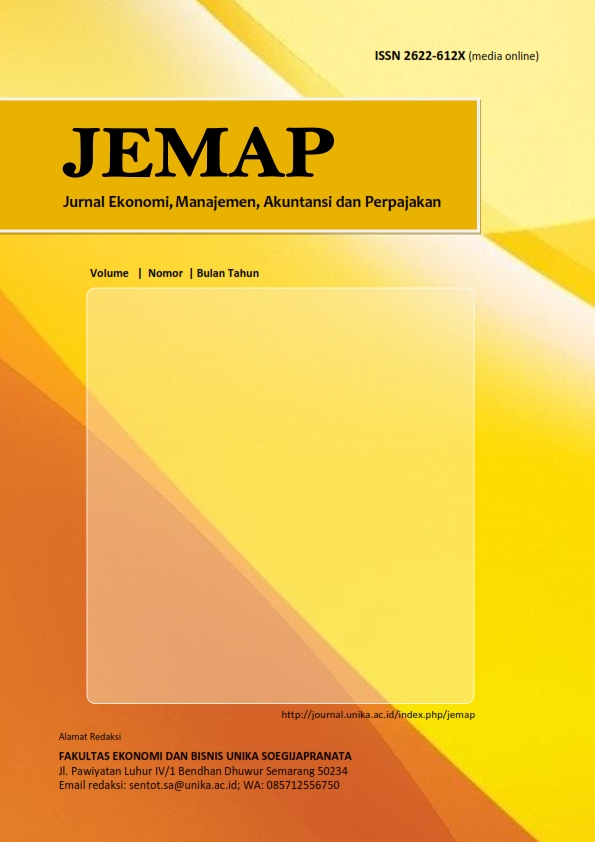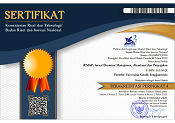Pengaruh Life Cycle Perusahaan Terhadap Tax Avoidance Pada Emiten Bei Periode 2017-2019
Abstract
The study aims to prove the relationship between the firm's life cycle stages and tax avoidance. This study uses Dickinson (2011) model as the proxy of the life cycle stages, which based on cash flow patterns. The sample in this study are 195 companies engaged in the manufacturing sector that listed on the Indonesia Stock Exchange (IDX). The results of regression model shows that firm life cycle stages have a significant determinant on the tendency of companies do tax avoidance. This study is expected to be useful for management, investors, and academics as a guide to make a better decision.
Keywords
Full Text:
PDF (Bahasa Indonesia)References
Annuar H.A., Salihu I.A., & Obid S.N.S. (2014). Corporate ownership, governance and tax avoidance: An interactive effects. Procedia - Social and Behavioral Sciences, 164: 150-160.
Arieftiara, D., Wardhani, R., & Rahayu. (2013). Analisis Pengaruh Strategi Bisnis terhadap Penghindaran Pajak, Bukti Empiris di Indonesia. Universitas Indonesia.
Austin, C. R., & Wilson, R. J. (2013). Are Reputational Costs a Determinant of Tax Avoidance? Working Paper.
Bandura, A. (1969). Social-Learning Theory of Identificatory Processes. In David A. Goslin, ed., Handbook of Socialization Theory and Research. Rand McNally, 1969b.
Barclay, M., & Smith, C. (2005). The capital structure puzzle: The evidence revisited. Journal of Applied Corporate Finance, 17(1): 8–17.
Black, E. 1998. Life-cycle impacts on the incremental value-relevance of earnings and cash flow measures. Journal of Financial Statement Analysis 4 (1): 40–56.
Chen Z., Dhaliwal, D.S., & Xie, H. (2010). Regulation fair value disclosure and the cost of equity capital. Review of Accounting Studies, 15(1): 106–144.
Darmadi, I. N. H. (2013). Faktor yang Mempengaruhi Manajemen Pajak dengan Indikator Tarif Pajak Efektif: Studi Empiris pada Perusahaan Manufaktur yang Terdaftar di Bursa Efek Indonesia pada Tahun 2011-2012. Skripsi. Semarang: Fakultas Ekonomika dan Bisnis, Universitas Diponegoro.
Darmodjo, H., & Kaligis, Y. (2001). Ilmu Alamiah Dasar Edisi Revisi. Jakarta: Universitas Terbuka.
Dewi, et al. (2017). Pengaruh Tax Planning dan Ukuran Perusahaan Terhadap Manajemen Laba (Studi Empiris Pada Perusahaan Property yang Terdaftar di Bursa Efek Indonesia). Forum Ilmiah Pendidikan Akuntansi-Universitas PGRI Madiun, 5(1).
Dianty, A. T., & Midiastuty, P. P. (2018). Siklus Hidup Perusahaan Dan Penghindaran Pajak. Undergraduated thesis, Universitas Bengkulu.
Dickinson, V. (2011). Cash flow patterns as a proxy for firm life cycle. The Accounting Review, 86(6): 1969–1994.
Drake, K. (2015). Does firm life cycle explain the relation between book-tax differences and earnings persistence?. Working Paper.
Drobetz, W., Halling, M., & Schroder, H. (2015). Corporate life-cycle dynamics of cash holdings. Working Paper.
Dyreng, S. D. (2008). Long‐Run Corporate Tax Avoidance . The Accounting Review , 61–82.
Edwards, A., Schwab, C., & Shevlin, T. (2016). Financial constraints and cash tax savings. The Accounting Review, 91(3), 859–881.
Efferin, S., (2016). Sistem Pengendalian Manajemen Berbasis Spiritualitas. Rumah Peneleh: Sari Media Literasi
Filatotchev, I., Toms, S., & Wright, M. (2006). The firm’s strategic dynamics and corporate governance life-cycle. International Journal of Managerial Finance, 2(4), 256–279.
Ghozali, Imam (2013). Ekonometrika-Teori, Konsep dan Aplikasi dengan SPSS 23. Badan Penerbit Diponegoro: Semarang.
Graham J.R., Hanlon, M., Shevlin, T., & Shroff, N. (2014). Incentives for Tax Planning and Avoidance: Evidence from the Field. The Accounting Review 89(3), 991–1023.
Hanlon, M., & Heitzman, S. (2010). A review of tax research. Journal of Accounting and Economics, 50(2-3),127–178.
Hasan, M. M., Al-Hadi, A., Taylor, G., & Richardson, G. (2016). Does a Firm’s Life Cycle Explain its Propensity to Engage in Corporate Tax Avoidance?
Higgins, D., Omer, T., & Phillips, J. (2015). The influence of a firm’s business strategy on its tax aggressiveness. Contemporary Accounting Research, 32(2), 674–702.
Hoque, et al. 2011. Tax Avoidance Crimes-A Study on Some Corporate Firms of Bangladesh.
Irawan, F., Afif, A., R. (2020). Does Firms’ Life Cycle Influence Tax Avoidance? Evidence from Indonesia. International Journal of Innovation, Creativity and Change, Vol. 14, No. 1.
Irianto, Dr. Bambang Setyobudi., Yudha Aryo Sudibyo., & Abim Wafirli S.Ak. 2017. The Influence of Profitability, Leverage, Firm Size and Ca[ital Intensity Towards Tax Avoidance. International Journal of Accounting and Taxation, Vol. 5, No. 2, pp. 33-41.
Javanovic, B. (1982). Selection and evolution of industry. Econometrica, 50(3), 649–670.
Jenkins, D., Kane, G., & Velury, U. (2004). The impact of the corporate life-cycle on the value-relevance of disaggregated earnings components. Review of Accounting and Finance, 3(4), 5–20.
Kemenkeu. (2019). “Industri Manufaktur Makin Produktif dan Kompetitif”. https://www.kemenkeu.go.id/publikasi/berita/industri-manufaktur-makin-produktif-dan-kompetitif/. (diakses pada November 2020).
Kemenkeu. (2020). “Ini Realisasi Penerimaan Negara di Penghujung 2019”. https://www.kemenkeu.go.id/publikasi/berita/ini-realisasi-penerimaan-negara-di-penghujung-2019/. (diakses pada Januari 2021).
Koester, A., Shevlin, T., & Wangerin, D. (2013). Does operational efficiency spill over onto the tax return? Working Paper.
Lanis, R. and Richardson, G. (2012) Corporate Social Responsibility and Tax Aggressiveness: An Empirical Analysis. Journal of Accounting and Public Policy, 31, 86-108.
Lestari, Diana. 2015. Pengaruh Corporate Governance dan Intensitas Persediaan Terhadap Manajemen Pajak (Studi Empiris Pada Perusahaan Manufaktur Yang Terdaftar di Bursa Efek Indonesia Tahun 2011-2013). Jom FEKON Vol.2 No.2 Oktober 2015.
Lestari, T., Suranta, E., Midiastuty, P.P., & Fachruzzaman, F. (2020). Pengaruh Siklus Hidup Perusahaan Terhadap Penghindaran Pajak dengan Manajemen Laba Sebagai Variabel Intervening. Jurnal Akuntansi, Keuangan, dan Manajemen, 1(3). 169-180.
Mahoney, J.T. (1995). The Management of Resources an The resource of Management. Journal of Business Research, 33 (2): 91-101.
Mathis, R.L., & John, H.J. (2006). Manajemen Sumber Daya Manusia Edisi Pertama. Jakarta: Salemba Empat.
McGuire S.T., Omer, T., & Wang, D. (2012). Tax avoidance: Does tax-specific industry expertise make a difference? The Accounting Review, 87 (3): 975–1003.
Melisa, M., dan Tandean, V. A. (2017). Factor-faktor yang Mempengaruhi Penghindaran Pajak (Tax Avoidance). Jurnal Akuntansi Bisnis Vol. 8 No.1.
Miller, D., & Friesen, P. (1984). A longitudinal study of the corporate life cycle. Management Science, 30(10),1161–1183.
Mueller, D.C. (1972). A life cycle theory of the firm. The Journal of Industrial Economics, 20(3), 199–219.
Permata, A., Nurlaela, S., dan Wahyuningsih, E. (2018). Pengaruh Size, Age, Profitability, Leverage dan Sales Growth Terhadap Tax Avoidance. Jurnal Akuntansi dan Pajak, 19(1), 10-20.
Penrose, E. (1959). Contributions to the Resource-Based View of Strategic Management. Journal of Management Studies , 41(1), 183-191.
Rego, S.O. (2003). Tax-avoidance activities of U.S. multinational corporations. Contemporary Accounting Research, 20(4), 805–833.
Robins, S., P. 2001. Perilaku organisasi: Konsep, Kontroversi, Aplikasi, Jilid 1, Edisi 8. Jakarta: Prenhallindo.
Spence, M. 1981. The learning curve and competition. Bell Journal of Economics 12 (1): 49–70.
Umar, H. (1999). Metode Penelitian: Aplikasi dalam Pemasaran. Jakarta: PT Gramedia Pustaka Utama.
Undang-Undang Republik Indonesia Nomor 28 Tahun 2007 Tentang Ketentuan Umum Perpajakan
Wilson, R.J. (2009). An examination of corporate tax shelter participants. The Accounting Review, 84(3), 969–999.
DOI: https://doi.org/10.24167/jemap.v5i1.3703
Refbacks
- There are currently no refbacks.
e-ISSN 2622-612X | View My Stats







